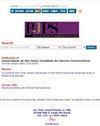Determination of cyanide in whole seeds and brans of linseed (Linum usitatissimum Linn) by molecular spectrophotometry
IF 0.9
4区 医学
Q4 PHARMACOLOGY & PHARMACY
引用次数: 0
Abstract
The addition of linseed ( Linum usitatissimum Linn) in the diet, as a functional food, has increased over the years. However, it possesses cyanogenic glycosides. This study aimed to quantify and compare cyanide concentration in whole seed and bran of brown and golden types to establish a safe limit of intake. Three commercial labels, from brown and golden whole seed types (Ab, Ag, Bb, Bg, Cb and Cg), and six commercial labels of brown and golden bran (1b, 2g, 3g, 4b, 5g, and 6b), were selected, totalizing twelve samples. Total cyanide concentration was quantified by a colorimetric method employing alkaline picrate, after acid hydrolysis. The whole seed cyanide values were between 348.4 and 473.20 µg/g and the bran cyanide values were between 459.53 and 639.35 μg/g. The analyzed bran presented increased cyanide concentrations than the whole seeds with no differences between brown and golden types. Food able to produce cyanide less than 90 µg/kg body weight, daily, is considered secure for consumption. Considering this limit and analyzed samples, it is safe to eat approximately two tablespoons of seeds or one tablespoon of bran. These results point out the importance of cyanide amount daily intake information to be in linseed packaging, to ensure secure consumption.分子分光光度法测定亚麻籽(Linum usitatissimum Linn)中氰化物的含量
亚麻籽(Linum usitatissimum Linn)作为一种功能性食品,在日粮中的添加量逐年增加。然而,它含有氰苷。本研究旨在量化和比较棕色和金色品种的全籽和麸皮中的氰化物浓度,以确定安全摄入量。选取棕色和金色全种(Ab、Ag、Bb、Bg、Cb和Cg) 3个商业标签,以及棕色和金色麸皮(1b、2g、3g、4b、5g和6b) 6个商业标签,共12个样本。酸水解后,用碱性苦味酸比色法测定总氰化物浓度。全籽氰化物值在348.4 ~ 473.20 μg/g之间,麸皮氰化物值在459.53 ~ 639.35 μg/g之间。分析的麸皮氰化物浓度高于整个种子,棕色和金色种子之间没有差异。每日产生氰化物少于90微克/公斤体重的食物被认为是安全的。考虑到这个限制和分析样本,食用大约两汤匙种子或一汤匙麸皮是安全的。这些结果表明,在亚麻籽包装上标注每日氰化物摄入量信息,对保证食用安全具有重要意义。
本文章由计算机程序翻译,如有差异,请以英文原文为准。
求助全文
约1分钟内获得全文
求助全文
来源期刊

Brazilian Journal of Pharmaceutical Sciences
PHARMACOLOGY & PHARMACY-
CiteScore
1.40
自引率
0.00%
发文量
165
审稿时长
7.5 months
期刊介绍:
The Brazilian Journal of Pharmaceutical Sciences accepts for publication Original Papers applicable to the fields of Pharmaceutical Sciences; Reviews and Current Comment Articles, which are published under the Scientific Editor and Associate Editors invitation to recognized experts or when they are spontaneously submitted by the authors in the form of abstracts to have their importance evaluated. A critical view of the subject with insertions of results of previous works in the field in relation to the state of art must be included; Short Communications reporting new methods and previews of works on researches of outstanding importance in which originality justify a quick publication. A maximum of 2000 words excluding tables, figures and references is an acceptable limit. One table, one figure and ten references may be added, and Book Reviews of the latest editions of books, prepared by specialists invited by the Scientific Editor and Associate Editors. Thematic Supplements as well as those related to scientific meetings can be published under the Scientific Editor and/or Associate Editors agreement.
 求助内容:
求助内容: 应助结果提醒方式:
应助结果提醒方式:


